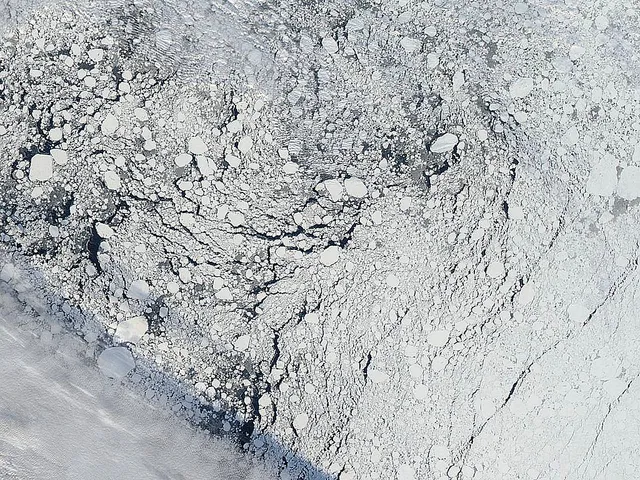Will next year's summer Arctic ice extent be high or low? Can ship captains plan on navigating the famed Northwest Passage—a direct shipping route from Europe to Asia across the Arctic Ocean—to save on time and fuel? A new study says year-to-year forecasts of the Arctic's summer ice extent are not yet reliable.
Scientists at the National Snow and Ice Data Center (NSIDC), University College London, University of New Hampshire and University of Washington analyzed 300 summer Arctic sea ice forecasts from 2008 to 2013 and found that forecasts are quite accurate when sea ice conditions are close to the downward trend that has been observed in Arctic sea ice for the last 30 years. However, forecasts are not so accurate when sea ice conditions are unusually higher or lower compared to this trend.
"We found that in years when the sea ice extent departed strongly from the trend, such as in 2012 and 2013, predictions failed regardless of the method used to forecast the September sea ice extent," said Julienne Stroeve, a senior scientist at NSIDC and professor at University of College London. Stroeve is lead author of the study, published recently in Geophysical Research Letters.
"That downward trend reflects Arctic climate change, but the causes of yearly variations around the trend are harder to pin down," said Lawrence Hamilton, co-author and a researcher at the University of New Hampshire. "This collection of forecasts from many different sources highlights where they do well, and where more work is needed."
Arctic sea ice cover grows each winter as the sun sets for several months, and shrinks each summer as the sun rises higher in the northern sky. Each year, the Arctic sea ice reaches its minimum extent in September. Scientists consider Arctic sea ice as a sensitive climate indicator and track this minimum extent every year to see if any trends emerge.
Multi-channel passive microwave satellite instruments have been tracking sea ice extent since 1979. According to the data, September sea ice extent from 1979 to 2013 has declined 13.7 percent per decade. The recent years have shown an even more dramatic reduction in Arctic ice. In September 2012, Arctic sea ice reached a record minimum: 16 percent lower than any previous September since 1979, and 45 percent lower than the average ice extent from 1981 to 2010.
Long-term predictions of summer Arctic extent made by global climate models (GCMs) suggest that the downward trend will likely lead to an ice-free Arctic summer in the middle of the century. GCMs are in overall agreement on loss of Arctic summer sea ice as a result of anticipated warming from the rise in greenhouse gases this century.
Shorter-term forecasts of summer ice extent are harder to make but are now in high demand. The shrinking ice has caught the attention of coastal communities in the Arctic and industries interested in extracting resources and in a shorter shipping route between Europe and Asia.
Many of the forecasts analyzed in the study focused on the state of the ice cover prior to the summer melt season. According to the study, including sea ice thickness and concentration could improve the seasonal forecasts.
"It may even be possible to predict sea ice cover a year in advance with high-quality observations of sea ice thickness and snow cover over the whole Arctic," said Cecilia Bitz, co-author and professor of atmospheric sciences at the University of Washington.
"Short term predictions are achievable, but challenges remain in predicting anomalous years, and there is a need for better data for initialization of forecast models," Stroeve said. "Of course there is always the issue that we cannot predict the weather, and summer weather patterns remain important."
The study analyzed forecasts from the Study of Environmental Arctic Change (SEARCH) Sea Ice Outlook, a project that gathers and summarizes sea ice forecasts made by sea ice researchers and prediction centers. Contributors to the SEARCH Sea Ice Outlook project employ a variety of techniques to forecast the September sea ice extent, ranging from heuristic, to statistical, to sophisticated modeling approaches.
The National Science Foundation and the Office of Naval Research supported the study.
Information
Download a copy of the study here.
Read more on Julienne Stroeve's research on her NSIDC scientist bio page.
For more on the Study of Environmental Arctic Change (SEARCH) Sea Ice Outlook, see their Web site.
For a regular analysis of sea ice conditions in the Arctic, see NSIDC's Arctic Sea Ice News & Analysis page.
Media Contacts
Natasha Vizcarra, National Snow and Ice Data Center Media Liaison, +1 303.492.1497, press@nsidc.org
Lori Wright, University of New Hampshire Media Relations, +1 603.862.0574, lori.wright@unh.edu
Hannah Hickley, University of Washington Media Relations, +1 206.543.2580, hickeyh@uw.edu
